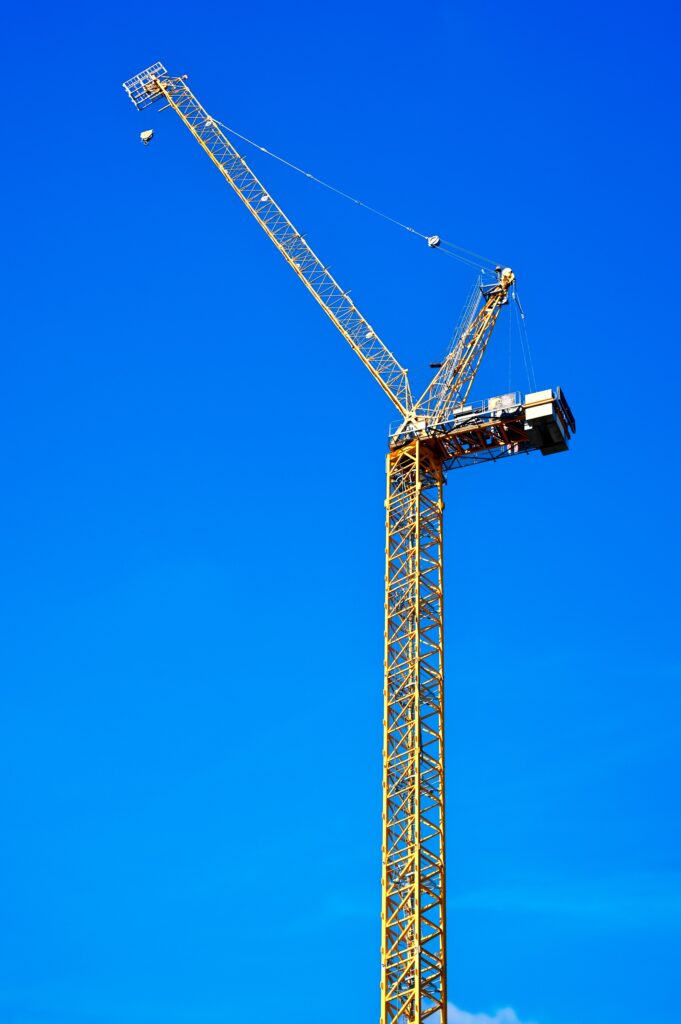Well, for clarification, it has nothing to do with a species of bird. We are discussing a mechanized system that is utilized for a mechanical advantage to lift a load.
Mechanical Advantage
A crane is a simple machine that is designed to provide a mechanical advantage when lifting and placing a load. A mechanical advantage is a measure of the force amplification achieved by using a tool, mechanical device, or machine system. The device trades off input forces against movement to obtain a desired amplification in the output force.
You might be thinking, “cranes are not simple machines and there are many computations in designing the various available cranes,” and I agree that they are not simple in that regard. But I would argue they are as simple as describing them as a lever and fulcrum. How do a lever and fulcrum describe a crane? We can describe the boom as a lever, and the boom’s hinge pin as the fulcrum. The lever and fulcrum have been used for thousands of years. One of the earliest known cranes utilizing a lever and fulcrum is called a Shaduf (see more info on a Shaduf below).
Balance and Leverage
Many of you understand the principal of balance and leverage, and you may have not been successful in describing these words when you were young, but you were physically aware of them.

The playground seesaw is an example of a lever. The tube looking thing mounted into the earth the seesaw rests upon is the fulcrum, or pivot point. The fulcrum never moves. For example, I was a hefty kid, so there was never much effort (force) on my part to elevate the individual on the opposite side of the seesaw, and the individual that I elevated (load/work) was helpless in their efforts to force their side of the seesaw down to elevate me. Of course, as kids, we would then add another person to their side, a counterweight if you will, and off we went enjoying our time on the seesaw, as the loads were now balanced. When effort was exerted up by one side it moved the mass down on the other side. — See Saw Physics Lesson
Pulleys and Sheaves

Rope reeving over sheaves
Pulleys and sheaves are mechanisms also utilized within this mechanized system to lift and move a load. When a wire rope is reeved over sheaves into multi parts of line, each line increases the mechanical advantage of the crane. When wire rope is two-parted the effort to lift and move the load is two times less, but you are using two times the wire rope distance.
Example: The load to be lifted is 10,000 pounds, and it needs to be elevated 50 feet to a rooftop. Separately, each line effort would be 5,000 lbs. as each line is sharing the load’s weight; however, the wire rope length to accomplish this lift would be twice the height of 50 feet. 100 feet of wire rope would be required beyond the main boom sheave point. Simply stated: The sheaves allow the crane to apply less force over a greater distance to lift a load.
Counterweight
Counterweight is a weight used to counterbalance an opposing load. The load weight, weight distribution when rigged, size, shape, and position are key factors affecting the capacity and the stability of the mechanized system used for lifting and moving a load. The leverage of this mechanized system must be calculated to exceed the effort of an object to be lifted and moved.
The areas before the tipping axis of a crane, aka fulcrum, is known to be the crane leverage, and anything beyond the tipping axis is known as the load’s leverage. When loads are nearing balance, meaning both sides are equal, the stability of the mechanized system is in jeopardy. A load weight that exceeds the crane’s leverage will cause the crane to tip in the direction of the load.
Note: When a crane lifts and moves a load, the cranes center of gravity will be affected. The distance/radius from the load’s center of gravity to the crane’s tipping axis will impact the cranes center of gravity. The crane’s boom is often the culprit of a tip over. The radius or distance to the loads must be considered in the cranes stability. A load-chart that identifies the crane must be used to plan a lift.
Four Basic Components of Mobile Cranes
With mobile cranes, there are four basic components. Each of these components that have their own individual center-of-gravity (COG). These components are:
- superstructure
- counterweights
- carrier
- boom
When the crane is assembled with these four components, they will no longer have their own COG, they instead, will have a combined-center-of-gravity (CCOG).
The limiting factors to any mechanized system is the strength of the individual materials used within the mechanized system. Wire rope is one of those materials often overlooked and in certain opportunities will be your weakest link in a lifting operation. The crane operator, lift director, and planner must know the permissible load-line-pull of the wire rope being utilized for a lifting operation, exceeding this value may cause a catastrophic failure to the crane and load.
Crane defined by authorities on cranes:
Wikipedia defines a crane, “A crane is a type of machine, generally equipped with a hoist rope, wire ropes or chains, and sheaves, that can be used both to lift and lower materials and to move them horizontally. It is mainly used for lifting heavy objects and transporting them to other places.”
OSHA defines a mobile crane in construction as “Mobile crane means a lifting device incorporating a cable suspended latticed boom or hydraulic telescopic boom designed to be moved between operating locations by transport over the road.”
OSHA defines a crane for general industry as a machine for lifting and lowering a load and moving it horizontally, with the hoisting mechanism an integral part of the machine. Cranes, whether fixed or mobile, are driven manually or by power.
Two Main Categories of Cranes: Static and Mobile
Static Cranes

A static crane, such as a tower crane, is typically fixed and moves its load on a fixed path. Another example of a static crane is an overhead crane. An overhead crane travels with its load on fixed rails. Other known static cranes are pedestal, self-erecting cranes, jacking towers (strand jacking), and cableways.
A Brief History of Static Cranes
A Shaduf (Shadoof) is one of the earliest forms of a crane (3000 BCE) and is one type of a static crane. A shaduf was made out of simple materials. A material list was very comprehensive…. not really. This list starts out with a long, fairly straight – column like wooden pole that when installed is rested onto a fork from the main body of a tree’s trunk. Then lash another long pole with an attached bucket to scoop water from its source. A Shaduf utilizes a lever arm, basically a stiff bar to pivot or hinge on the fork (fulcrum) of tree trunk. When positioned at different distances from its fulcrum the force applied can be lessen or increased. The Shaduf was used primarily in lifting water out of a well or a waterway and used for crop irrigation by lifting from its source and depositing the captured water onto an irrigation channel that led to the fields were crops were planted.
“The mechanical advantage of using a long lever to lift a heavy weight is apparent; much less force is need to lift a heavy object with a lever if the distance from the pivot point is large compared to the distance of the heavy object from the pivot point.”
Mobile Crane

Mobile cranes typically are the most versatile of all cranes manufactured as they are not limited by fixed structures or rails. Mobile cranes are used in just about all industries, such as: home building, commercial construction, bridges and highways, heavy industries, and maritime work.
Examples of mobile cranes are: Carry Deck, Crawler Crane, Floating Crane, Rough Terrain Crane, Truck Mounted / Boom Truck Crane, All Terrain Crane and a Pick and Carry Crane.
A Brief History of Mobile Cranes
I like to know the origins of something I like, and I was curious as to when the first mobile crane was produced, and this is what I discovered.

One of the very first mobile cranes was produced by Henry James Coles Limited. This crane was developed by Arnold Hallsworth, a pupil apprentice at the time. He was tasked to develop a mobile crane for General Pershing’s Expeditionary Force. Cranes in this time period (WWI) were typically affixed to railcars. Young Hallsworth developed, what is perceived by many in the industry, as the first mobile crane. This mobile crane was mounted onto a Tiling Stevens bus chassis that boasted a petrol electric power plant, and with rotating upperworks.
I hope you enjoyed, this article. Every time I write about a topic I discover how much of the topic I was unaware of, so for me, this is always an enjoyable assignment.
“Knowledge is power” – Francis Bacon

